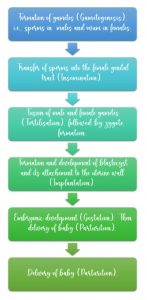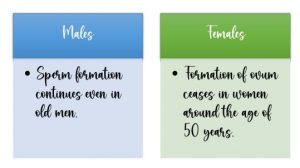Human Reproduction
Summary:
Humans reproduce sexually and are viviparous, and the reproductive events occur after puberty. The male reproductive system includes a pair of testes, accessory ducts, glands, and external genitalia, while the female reproductive system consists of a pair of ovaries, a pair of oviducts, a uterus, a cervix, a vagina, and the external genitalia. The testes produce sperm through the process of spermatogenesis, while the ovaries produce the ovum through the process of oogenesis. The fertilization of the ovum by the sperm occurs in the ampullary region of the oviduct. During pregnancy, a hormone called Human Chorionic Gonadotropin (hCG) is produced, and after implantation, finger-like projections called Chorionic Villi appear on the trophoblast. The process of delivery of the fetus is called Parturition, and the production of milk in the mammary glands after childbirth is called Lactation.
Excerpt:
Human Reproduction
- Humans reproduce sexually and are viviparous.
- The reproductive events in humans include:

Human Reproduction
- Reproductive events occur after puberty.
- Differences between in the male and in the female:

Human Reproduction
…
- Oviducts (Fallopian Tubes):
- Each fallopian tube is about 10-12 cm long and extends from the periphery of each ovary to the uterus.
- The part closer to the ovary is the funnel-shaped Infundibulum.
- The edges of the infundibulum possess finger-like projections called Fimbriae, which help in the collection of the ovum after ovulation.
- The infundibulum leads to a wider part of the oviduct called
- The last part of the oviduct, the Isthmus, has a narrow lumen, and it joins the uterus
….
● Structure of Sperm:
➔ Composed of a head, neck, middle piece and tail.
➔ Plasma membrane envelops the whole body of sperm.
➔ The sperm head contains an elongated haploid nucleus.
➔ Anterior portion is covered by a cap-like structure, Acrosome, which is filled with enzymes that help fertilise the ovum.
➔ The middle piece possesses numerous mitochondria, which produce energy for the movement of the tail.
➔ Tail facilitates sperm motility.


Reviews